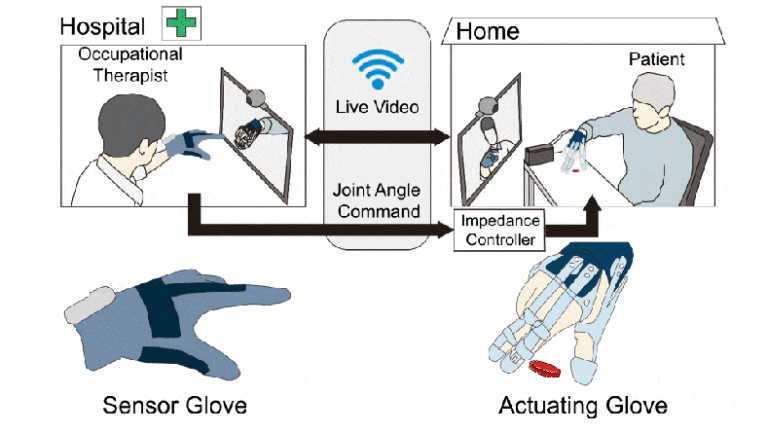Interaction between the patient and the occupational therapist is essential for effective functional rehabilitation. Unlike other body parts, therapists encounter difficulty in physically interacting with the hand involving a large number of degrees of freedom (DOFs). Recently, wearable hand-rehabilitation robots that could assist high-DOF movements enabled the training of various hand postures. However, they mostly lack an intuitive control scheme that can incorporate interaction with a therapist to manage many DOFs. Thus, we present a soft wearable unilateral telerobotic system that enables various grasping tasks and cooperative interaction between the patient and therapist.
The presented system consists of a sensor glove that measures the hand postures of the occupational therapist and a soft robotic glove that assists 4-DOF movements of the patient’s hand, including adjustments of the interjoint coordination of the finger and 2-DOF movements of the thumb (flexion/extension and opposition/reposition). The soft robotic glove effectuates hand movements based on the measurements from the sensor glove. A telerobotic impedance-control scheme provides intuitive guidance of various hand postures, along with a fingertip-force vector with a motion-initiation control delay of 100 ms.
The kinematic and kinetic improvements by physical assistance by the therapist using the system were experimentally evaluated for a healthy recruit and a stroke survivor. The presented system increased the patient’s thumb workspace by 400% in palmar-dorsal direction and enabled the fingertip-force direction to be adjusted at -30°∼10° range. These features facilitate patients to perform stable object grasping in the major grasping postures (power grasp, pinching, tripod grasp, lateral grasp). The presented rehabilitation system is suitable for noncontact telehealthcare that facilitates patient-therapist interactions.

